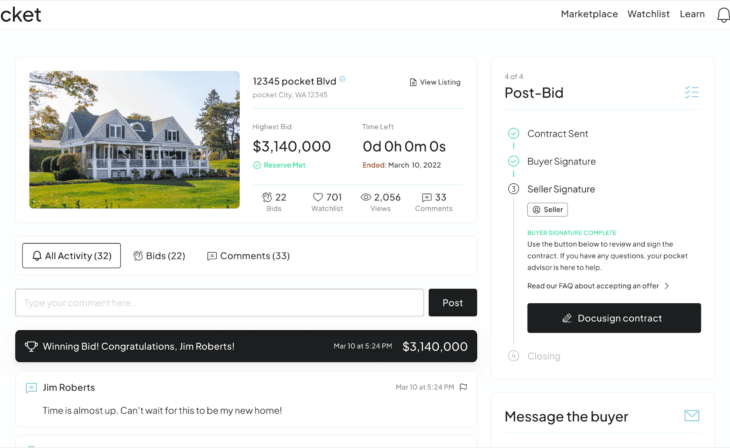It is important for both buyers and sellers to understand the periods of time in the PSA. Not only what they are but how they are written. For that reason and to the detriment of its readability, this guide includes a lot of the legal vocabulary and syntax you are likely to encounter in a PSA.
Many of the terms found in the Purchase and Sale Agreement (PSA), such as contingencies, require an action to be performed by the buyer, the seller, or both within a specific period of time. If the action or actions are not performed or performed outside of the period of time specified, the term may be forfeited or the contract terminated.
Periods of time in every PSA, unless otherwise stated, adhere to the following:
- All periods of time are counted in calendar days.
- A period of time starts the calendar day after the triggering event.
- A period of time expires at 6:00 p.m. on the last day of the period.
- If the last day of a period of time is a non-business day, the period expires on the next business day (except for offers or counteroffers, they expire on the day indicated).
It is important to note, that the notification of the completion of any actions required within a specific period of time must be delivered in writing and signed.
Below are some of the most common terms you will find in the PSA, the actions that need to be taken to satisfy those terms and the specific periods of time for those actions to be taken. Let’s start with an easy one.
Earnest money
Within 5 days – of mutual acceptance and before the buyer’s inspection, the buyer will provide the closing agent with the earnest money.
Contingencies
All contingencies have an action or actions that are required to be taken by the buyer and/or seller to satisfy the contingency. In most cases, if any action is taken by the buyer then a response is required from the seller.
Financing
There are several periods of time that may be important to the actions that need to be taken to satisfy or waive the financing contingency.
These include:
- Within 5 days: of mutual acceptance, the buyer must apply for a loan with a federally insured commercial lender. If the buyer fails to apply for a loan within 5 days then the buyer waives this contingency.
- After 14 days: from mutual acceptance, if the seller believes the buyer will be unable to obtain financing, the seller can give the buyer notice demanding that the buyer waive this contingency.
If the seller gives the buyer notice:
- Within 5 days: after receiving notice from the seller, the buyer must waive this contingency. If the buyer does waive the contingency, then the agreement terminates.
Appraisal
In the event of a low home appraisal, depending on the terms of the PSA and the actions that need to be taken, one of the following periods of time may apply.
- Immediately: the buyer must increase their down payment by the difference between the appraised value and the purchase price. If the buyer does not increase their down payment, the buyer will be in breach of the agreement and will forfeit their earnest money,
Or
- Within 2 days: of receiving the low appraisal, the buyer can provide the seller notice of termination of the agreement.
Or
- Within reason: the buyer and seller can renegotiate the terms of the agreement in lieu of termination.
Title
The receipt and disapproval of the title commitment by the buyer could lead to several different actions that would need to be completed in specified periods of time.
- Within 5 days – of the receipt of the title insurance company’s commitment for title insurance, the buyer must give notice of disapproval. If the buyer does not provide notice within 5 days, then the buyer waives this contingency.
If the buyer disapproves:
- Within 5 days – the seller must respond to the buyer’s notice. The seller must agree to clear and resolve the buyer’s objections. Objections by the buyer are resolved by the removal of that special exception from the policy of title insurance. If the seller is unable to remove all identified special exceptions prior to the closing date, then the agreement will terminate.
If the buyer receives a supplemental commitment that discloses a new special exception, then the same time periods and procedures will apply, limited to the new special exception. The buyer’s right to object starts with the buyer’s receipt of the supplemental commitment.
Home Owners Association (HOA)
Within 5 days – of the receipt of the HOA Documents, the buyer must approve of the HOA requirements or terminate the agreement. If no notice is given by the buyer within the 5 day period, then the contingency will be satisfied.
Inspection
If the buyer decides to have the property inspected, a single or several actions will need to be taken, each within their own specific period of time depending on the results of the inspection and the buyer and seller’s responses.
- Within 10 days – of mutual acceptance, the buyer must have an inspection performed and give the seller notice if they disapprove of the inspection results. If the buyer fails to do so, then the buyer waives the inspection contingency.
If the buyer disapproves of the inspection, in the notice of disapproval, the buyer can either terminate the agreement or propose additional terms that will satisfy the contingency. The additional terms may include corrections or repairs to the property to be completed by the seller before the closing date.
If the buyer proposes additional terms:
- Within 5 days – of the buyer’s proposal, the seller must respond. The seller can either agree to the buyer’s proposed terms or disagree and propose additional terms of their own. If the seller agrees to the buyer’s proposed terms, then the contingency is satisfied and the new terms become part of the agreement.
If the seller disagrees and proposes their own additional terms:
- Within 3 days – of receipt of the seller’s additional terms, the buyer must respond by:
- Terminating the agreement.
- Accepting the seller’s additional terms.
- Negotiating with the seller and agreeing to new additional terms.
Otherwise, the buyer waives this contingency. If the buyer accepts the seller’s proposed terms, or if the parties agree on new additional terms, then the contingency is satisfied and new terms become part of the agreement.
If the seller agrees to make corrections or repairs, then all work will be done before the closing date.
Lead Paint
If the seller discloses that there is lead in the home or on the property, the buyer is given the opportunity to have a risk assessment or inspection performed. If the buyer waives the opportunity, then the contingency is satisfied. If the buyer decides to conduct the risk assessment or inspection then the following periods of time take effect.
- Within 10 days – of receiving the lead paint disclosure, the buyer must have the risk assessment or inspection performed and either approve of the findings or terminate the agreement.
If the buyer gives notice of disapproval of the risk assessment or inspection, the buyer’s notice must identify the specific existing deficiencies and corrections needed.
- Within 3 days – of receiving the buyer’s notice of disapproval, the seller must correct the conditions identified by the buyer. The corrections are at the seller’s expense, must be completed prior to the closing date, and certified by a risk assessor or inspector of the buyer’s choosing. Once the buyer receives the certification the contingency is satisfied.
In addition, the buyer and seller may agree on any other remedy for the disapproved condition(s) as identified by the buyer, including but not limited to cash payments from the seller to the buyer or adjustments in the purchase price. If such an agreement on non-repair remedies is secured in writing before the expiration of the time period for notice by Seller of intent to correct, then this contingency will be deemed satisfied.
More Common Terms
Below are additional examples of terms that must be met or actions that need to be taken during the closing period.
Utilities
The seller is responsible for all utility charges incurred through the closing date.
Condition of Title
Title will be marketable at closing. The title insurance policy to be issued at closing may not contain any exceptions, other than the general exclusions and exceptions, and special exceptions consistent with marketable title. If title cannot be made so insurable by the closing date, then the agreement will terminate.
Possession
This one is easy. The seller will deliver the keys to the buyer on the closing date. “Keys” include all keys, codes, and remote opening devices (such as garage door openers) for the property. The buyer is entitled to access and possession when the closing agent gives notice of closing.
That’s it!
As long as you know what you’re looking for and where to look, the periods of time and the actions they govern are fairly easy to understand. Those outlined above are what you will typically find in a PSA so use this guide as a cheat sheet to make sure you’ve checked all the time boxes for any terms included in your contract.
And, apologies for all of the legal jargon. We believe it is important to not only know what these items are but also how they are written. Familiarity with the PSA will help ease the contractual piece of the buying and selling process potentially saving you time and money.




